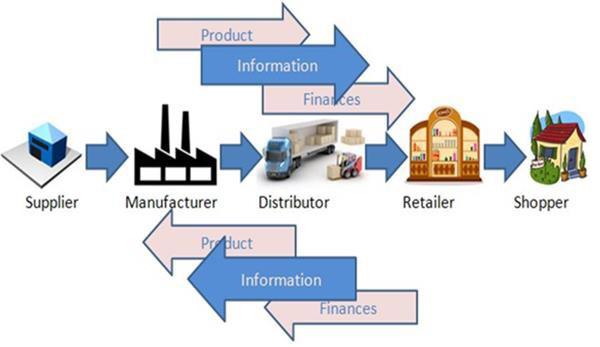Supply Chain Management - Introduction
Supply Chain Management can be defined as the management of flow of products and services, which begins from the origin of products and ends at the product’s consumption. It also comprises movement and storage of raw materials that are involved in work in progress, inventory and fully furnished goods.
The main objective of supply chain management is to monitor and relate production, distribution, and shipment of products and services. This can be done by companies with a very good and tight hold over internal inventories, production, distribution, internal productions and sales.

In the above figure, we can see the flow of goods, services and information from the producer to the consumer. The picture depicts the movement of a product from the producer to the manufacturer, who forwards it to the distributor for shipment. The distributor in turn ships it to the wholesaler or retailer, who further distributes the products to various shops from where the customers can easily get the product.
Supply chain management basically merges the supply and demand management. It uses different strategies and approaches to view the entire chain and work efficiently at each and every step involved in the chain. Every unit that participates in the process must aim to minimize the costs and help the companies to improve their long term performance, while also creating value for its stakeholders and customers. This process can also minimize the rates by eradicating the unnecessary expenses, movements and handling.
Here we need to note that supply chain management and supply chain event management are two different topics to consider. The Supply Chain Event Management considers the factors that may interrupt the flow of an effective supply chain; possible scenarios are considered and accordingly, solutions are devised for them.
Supply Chain Management - Advantages
In this era of globalization where companies compete to provide the best quality products to the customers and satisfy all their demands, supply chain management plays a very important role. All the companies are highly dependent on effective supply chain process.
Let’s take a look at the major advantages of supply chain. The key benefits of supply chain management are as follows −
Develops better customer relationship and service.
Creates better delivery mechanisms for products and services in demand with minimum delay.
Improvises productivity and business functions.
Minimizes warehouse and transportation costs.
Minimizes direct and indirect costs.
Assists in achieving shipping of right products to the right place at the right time.
Enhances inventory management, supporting the successful execution of just-in-time stock models.
Assists companies in adapting to the challenges of globalization, economic upheaval, expanding consumer expectations, and related differences.
Assists companies in minimizing waste, driving out costs, and achieving efficiencies throughout the supply chain process.
These were some of the major advantages of supply chain management. After taking a quick glance at the concept and advantages on supply chain management, let us take a look at the main goals of this management.
Supply Chain Management - Goals
Every firm strives to match supply with demand in a timely fashion with the most efficient use of resources. Here are some of the important goals of supply chain management −
Supply chain partners work collaboratively at different levels to maximize resource productivity, construct standardized processes, remove duplicate efforts and minimize inventory levels.
Minimization of supply chain expenses is very essential, especially when there are economic uncertainties in companies regarding their wish to conserve capital.
Cost efficient and cheap products are necessary, but supply chain managers need to concentrate on value creation for their customers.
Exceeding the customers’ expectations on a regular basis is the best way to satisfy them.
Increased expectations of clients for higher product variety, customized goods, off-season availability of inventory and rapid fulfillment at a cost comparable to in-store offerings should be matched.
To meet consumer expectations, merchants need to leverage inventory as a shared resource and utilize the distributed order management technology to complete orders from the optimal node in the supply chain.
Lastly, supply chain management aims at contributing to the financial success of an enterprise. In addition to all the points highlighted above, it aims at leading enterprises using the supply chain to improve differentiation, increase sales, and penetrate new markets. The objective is to drive competitive benefit and shareholder value.



